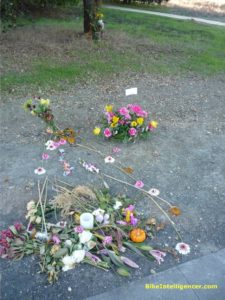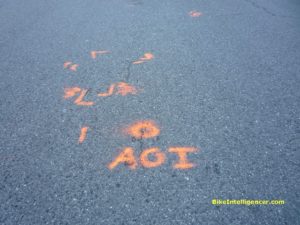UPDATE: On January 18, the California Highway Patrol investigated what it characterized as “new information” on Lauren Ward’s death. The CHP, which in December officially determined that Ward made an “unsafe turn” into the flatbed truck, indicated that the new information did not necessarily signal that its original determination would be invalidated. Following the original determination that Ward was at fault, her family filed a wrongful death lawsuit against the big-rig company.
More than two weeks after the death of cyclist Lauren Perdriau Ward, who was crushed by the wheels of a 26-wheel big rig on a popular cycling route near Palo Alto CA, her case still remains fogged by mystery.
Normally in a vehicle-and-bicycle mishap, it’s fairly easy to re-enact the accident scenario. There may be debate over who was at fault, but reconstructing the collision itself usually is straightforward.
In the case of Ward, an experienced 47-year-old cyclist, trained nurse and a “go-getter” mother of two, even the basics remain unclear. Lack of witness input, the hazardous nature of the intersection, the logistics of a big rig negotiating to approach a freeway on-ramp and the star-crossed driving record of a truck operator who has been involved in three fatal accidents over the past 7 years — all have served to complicate the post-accident investigation and leave cyclists scratching their heads about how the incident actually happened.
In addition, police are withholding their reports on grounds that publication could influence potential witnesses. So far, they say, no one who actually saw the accident has come forward.
This is particularly puzzling, given the mid-afternoon, sunny-day conditions and busy nature of the intersection. Last week Bike Intelligencer visited the scene at the same time of day, with similar weather conditions.
Site Well-Marked
The site was easy to find. Flowers marked the spot and painted police outlines of the accident were still visible on the pavement.
The “AOI” — area of impact — was on a slight incline in the west-bound lanes of Alpine Road following a stop sign just before an underpass for Interstate 280, a major freeway between San Jose and San Francisco. The big rig reportedly was headed for the northbound southbound on-ramp for 280, just past the underpass.
That course would have put the rig on an angular path from left to right across the outside lane of Alpine Road. In most traffic situations, that would put Ward to the right of the truck, the outermost area of clearance. But Ward, like many cyclists familiar with the intersection, apparently preferred to be on the left of traffic headed for the on-ramp to avoid conflicts with crossing vehicles.
Part of the problem is that the intersection contains no clear line of passage for cyclists. Observing it for more than half an hour, we saw cyclists adopting at least three different strategies for negotiating traffic. One was to ride between the two lanes of traffic to avoid cars angling to the freeway on-ramp. Another was to ride on the far right, next to the curb, and merge left while avoiding cars bound for the ramp. A third was to get up and ride or walk a sidewalk, then cross the on-ramp itself to re-enter Alpine Road.
None looked particularly safe. Even dismounting the bike left cyclists vulnerable and running for their lives to avoid speeding traffic entering the on-ramp.
Why No Witnesses?
What struck us and two other cyclists reviewing the accident scene is that no one has stepped forward with information about the accident. It’s impossible to imagine, on the front end of a Thursday-afternoon rush hour, no other drivers being around. The junction is a deafening jumble of cars and trucks traversing Alpine and the various on and exit ramps of 280.
It may be that in the din and congestion of a busy intersection, no one actually noticed Ward and her pink Trek being pulled beneath the truck. What seems more likely is that witnesses for one reason or another are not coming forward. Police presumably continue to hold out hope someone will have a change of heart.
Police reports may contain information about precisely where Ward struck or was struck by the big rig — a flatbed tractor-trailer carrying heavy equipment on a rear trailer. Under normal circumstances, however, the impact should not have happened.
Ward should have been easily noticeable on the left of the rig — whether the two started from the stop sign at the same time or, more likely, Ward was ahead. If the two were at the stop sign simultaneously, Ward would have easily pedaled ahead of the heavy rig and been in front, to the left. If the rig for some reason were ahead of Ward, e.g., she came to the stop sign after the rig began pulling away, she would have been easily seen in the driver’s mirrors.
The blind spot truck drivers worry about is on the right, said Eric Slind, a Teamster driver for more than three decades.
“The driver was probably looking more to his right to make sure he wasn’t cutting off anyone,” Slind said.
But that wouldn’t explain why, moving left to right, he would present an obstacle to Ward.
A tie-down block or other apparatus extending from the truck bed may have clipped Ward as the truck passed her, Slind speculated.
A photo published in local newspapers (see link below) shows what “looks like a large hi-lifter with a bucket, something used for working on high power lines or tree topping,” Slind commented. “It appears to be over 8 feet wide and would hang over the edge of the trailer, and the securing mechanism would protrude even further.”
It’s also possible that Ward for some reason lost control of her bike and crashed into the truck. Finally, a careless vehicle may have tried to pass Ward on her own left, “pinching” or even knocking her into the big rig’s path. The last scenario might explain why no witness, fearing culpability, has come forward.
A history of accidents
Absent police data on the accident, reports have focused on the problematic record of the big-rig driver — about whom at the very least it can be said he has a propensity for being in the wrong place at the wrong time.
Gabriel Manzur Vera, 44, a driver for nearly two decades for the demolition firm Randazzo Enterprises, struck and killed a 25-year-old Santa Cruz cyclist in a classic “right hook” three years ago. He was not charged in the incident but his employer later settled a wrongful death lawsuit by the family for a reported $1.5 million.
In 2003, Vera’s rig was struck head-on by a car that crossed the center line. Vera was not cited in that incident. Vera was involved in three other accidents between 2003 and 2007, and cited for speeding in 1998 and driving a commercial vehicle in a fire area in 2008.
Proper driver screening would have prevented Vera from being behind the wheel, said John Feder, a San Francisco attorney hired by the family.
Although Vera was not found at fault in previous fatalities, Slind said he is surprised Vera’s company’s insurer would allow him to keep driving.
“Normally the insurer would look at the driver’s record and a whole lot of red flags would go up,” Slind said.
The police investigation is expected to continue for two to three months. In the meantime, Silicon Valley cyclists can only speculate on how Lauren Ward got beneath the wheels of a 26-wheel big rig on a beautiful fall day along Alpine Road.
For further reading:
San Jose Mercury News photo of big rig
Lauren Ward’s letter to the editor pleading for “more respect and understanding” between cyclists and drivers
MTBR.com forum discussion on the accident
Lack of witnesses hinders the investigation
Gabriel Manzur Vera’s driving record

This one has had me scratching my head as well. The pinched from the left theory sounds the most likely to me.
I know Lauren’s husband, Bob Ward, very well. I have a very personal interest in this tragedy.
The above mentions: “The big rig reportedly was headed for the northbound on-ramp for 280, just past the underpass.” Other reports stated “southbound.” Can you clarify or correct?
Fritz K.
[Ed. Thanks Fritz, It looks from the map like that’s a cloverleaf, which would indeed make it southbound. Funny, as many times as I’ve biked through that interchange, I can’t recall ever having driven that on-ramp.]
An additional point and one I’ve tried to research in CA DMV Commercial Drivers License Guidebook: What size truck or load requires a “pilot vehicle” and “WIDE LOAD” warning signs and flags? Pictures of the commercial loader/forklift on the flat-bed appear on the verge of what might require such an escort. Anyone have any commentary on this specific issue?